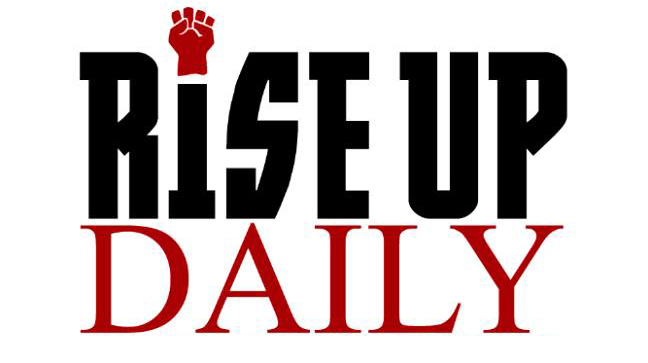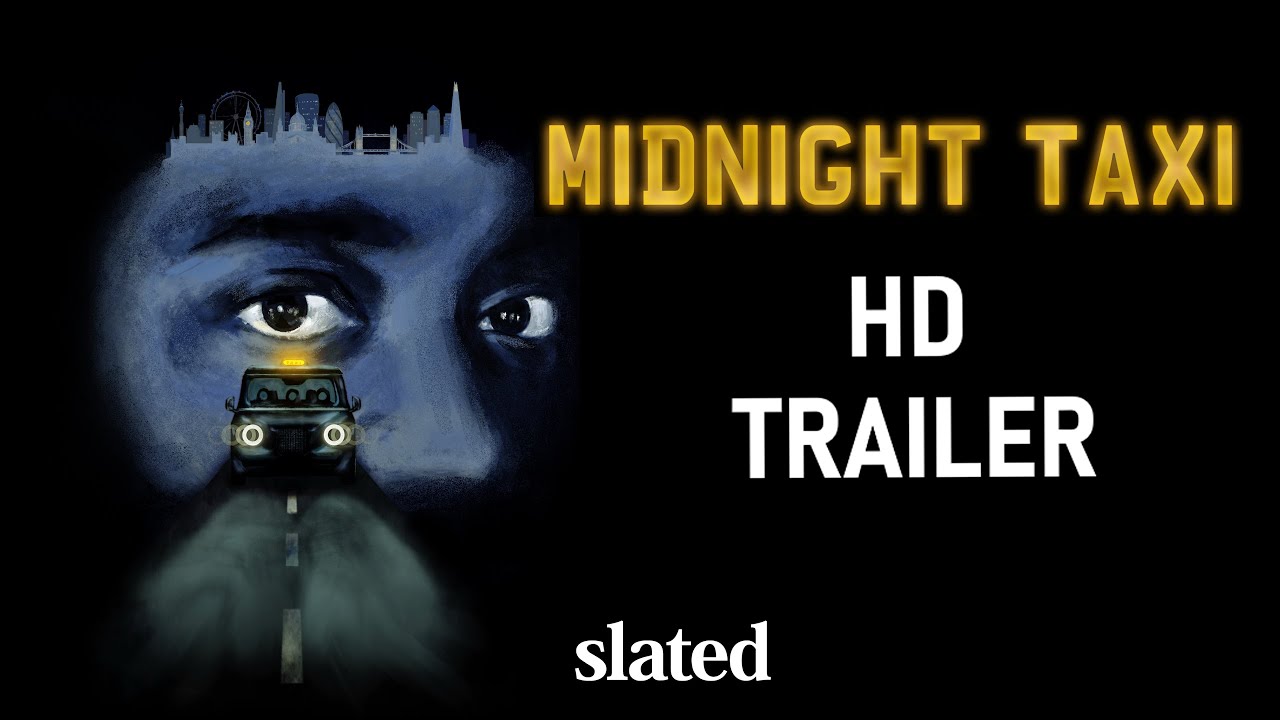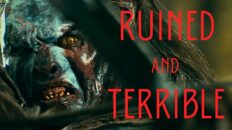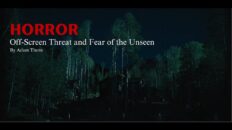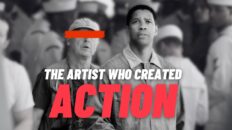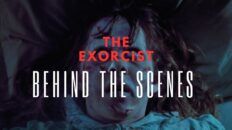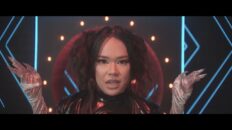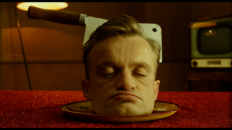Midnight Taxi is an intriguing tale, and there was a script you created before shooting, but how far from the original idea is the finished version of the film?
Bertie Speirs (BS): Our initial idea did not have sleepwalking and potential guilt as the motivation for finding what happened to Sabrina. Those additions came in later drafts, and really give the film a much more unhinged and unreliable narrator feeling, which I think really helps add to the noir mystery and makes the audience wonder what they can trust.
Samantha Speirs (SS): So I’d say the finished film is about 75-80% the same as the shooting draft. We had a few ambitious subplots and sequences for our time and budget so we expected some changes in the edit – and we had some! Our “nightmare” sequences in the finished film look radically different from the script, for example, and we have a subplot that was completely cut. There are tiny fragments from that plot line that are still in the finished film but it was probably a good 7-10 minute plot line – about four small scenes – that ended up on the cutting room floor.
Where did the idea come from? What was the inspiration?
SS: In the first few months of the pandemic, London was unrecognizable. I was walking our dog every day through areas that are never quiet – like Buckingham Palace, the South Bank, etc. – and was re-enamoured with the city. I said to Bertie that it’d be great to make a film in, around, and about London. I’m a big fan of murder mysteries so my mind was already spinning on that when Bertie came up with the idea for centering the story on a nightshift cab driver.
BS: I’ve always loved seeing cities in the quiet of the night. It gives such an eerie mood when you have this huge playground but almost no one else is around. Without the perceived safety of many regular people around at night, it makes the few strangers living at these times more intimidating and potentially dangerous – creating fear – good qualities for a thriller!
Did you rehearse with your cast before shooting began?
SS: Only briefly and only with a few. We were still in lockdowns during casting so all of our initial casting sessions were through video calls and virtual meetings. Luckily, our brilliant lead actor Ladi Emeruwa lived near us and we were able to coordinate with him to rehearse lines whilst driving the cab. We also had one afternoon where our hair and makeup artist and three of our lead cast were able to come around our flat for a socially distanced rehearsal and HMU test, which was great.
BS: We were lucky with the sheer number of talented people who self-taped and auditioned for roles in the film. Having such an extensive casting process helped us find actors who really fit the roles.
Were there no lighting crew with you on location? That would make the film completely shot with natural light, correct?
SS: That’s correct for the scenes with driving and on the streets.
BS: We didn’t have a full lighting crew, but in some non-driving sequences we used a few well-placed Aperture MCs. We also used a Fiilex 3 light kit in a few interior setups. We looked into programming lights for use inside the cab, to simulate passing vehicles and add some slight fill light. Two problems arose when investigating this – firstly that it might unnaturally clash with the real world, and more importantly that it might be distracting to other road users and potentially illegal. When testing the Sony A7s III camera, we realized its incredible low light sensitivity would help retain detail in the interior, and the real street lights ended up looking much more realistic than anything we could artificially create with lights on a sound stage or green screen studio.
I agree, the Sony Alpha series truly is unmatched when it comes to low light conditions! Now, this film was shot during COVID, but in your mind what is the year the film takes place?
SS: In my mind, it’s an alternate 2021 where everything is the same except that COVID never happened. We really wanted to make it feel like the “present day” but without any hint of the pandemic.
BS: If you watch incredibly closely, there is one article headline that mentions a fictional 2021 sporting event. A licensed black cab driver assisted the production as a second crew vehicle for all driving routes and scenes.
Can you walk us non-Londoners through the importance of this driver’s experience and how it elevated the storytelling?
SS: Part of the appeal of the story concept was the unique angle of the London cabbie. London cab drivers are the most highly trained cab drivers in the world. They train extensively to get a cabbie license – usually around 3 years – and pass a brutal exam known as “the Knowledge”. Not only do they learn approximately 25,000 street names and optimal routes throughout Central London but also what shows are on at all the major theatres, all of the hotels, etc. Studies have shown that London cab drivers have a larger memory area (the hippocampus) in their brains than non-cab drivers from all this knowledge – it’s incredible.
BS: The brilliant Tom Hutley (’Tom the Taxi Driver’ on YouTube) helped us make the film, and he gave us a few cultural pointers and driver-specific details throughout. We incorporated as many of these as we could, and others we unfortunately couldn’t as they would have added too much filming time to our brutally tight schedule. His ability to chat with anyone also really helped keep the mood light and everyone in good spirits – an invaluable addition during the cold night at 4am!
How many days of shooting were there with the car? Was that a daily rental cost for the car?
SS: We did 7 days of shooting while the car was driving plus another 13 days with the cab involved but stationary. We actually couldn’t rent an electric cab for shooting so we ended up having to buy one from outside London and we sold it after we finished shooting. Although an absolutely crazy decision at the time, it ended up being enormously helpful as we could prep, test, and shoot with the cab as much as we wanted and rig it up without worrying about rental damages.
The driving scenes were shot multi-cam with up to four cameras and eight microphones at once. That’s amazing. Having that much simultaneous coverage probably helped you limit the amount of takes and setups. How did you hide the cameras from each other’s field of vision?
BS: It was tricky! Before we began filming, we took a camera and tested every possible mounting location, with every lens combination. That way, we knew precise sight lines for every combination of position and lens – so we could hopefully keep the cameras out of each other’s shot frame. We created a cheat sheet of which locations and lens combinations could work together simultaneously, so we could try and have all 4 cameras in use as much as possible.
Were all four cameras the same camera?
BS: Yes – we filmed with four Sony A7s III. When filming anything in Multicam, we used the cameras’ internal recording. When we shot ’single cam’ sequences, scenes outside of the cab, we recorded raw externally into an Atomos Ninja V.
Were camera/lens reflections in the car a pain to work around?
BS: Occasionally – though the more prevalent issue was equipment shadows! Even with all our planning, we could not control where one camera’s shadow might move when a street light or different vehicle raced past. Shadows were constantly drifting in and out of the frame. Luckily, we had enough coverage to hide the vast majority of these distracting shadows in the edit but if you watch closely you might catch one or two! Thankfully, most viewers think these are the grab handles or some other part of the cab, so they don’t realize it’s the camera shadow at all.
In hindsight were the 8 mics a godsend, or too much effort for what ended up being usable in the final edit?
SS: A genius decision on Bertie’s part.
BS: We were very concerned that we would not be able to get actors back for ADR session so we wanted to ensure we got workable audio on location every time – we needed redundancy. Every mic had a pro and con inside the cab. The actors wore mics under the clothing, but sometimes a seatbelt slide would cause a rustle. The boom mics mounted on the doors had great quality, but would sometimes pick up road bumps, vibrations and motor noise. The headliner mics were less clear, but they provided a backup when all else failed. Using so many microphones did add a significant time burden during post production, selecting the best option, and using various audio tools to try and make each mic sound more consistent with the others.
Can you talk a bit about using the Xbox controller to remote control the cab shots? How did you come up with that system?
BS: We were using a new generation of DJI Ronin gimbal, and when filming cab to cab we needed to be able to control focus, zoom and pan/tilt/roll with the whole camera and gimbal setup on the roof of our camera car. We used the various focus motor attachments and paired those controls to the Xbox’s triggers, so we could smoothly guide the focus and zoom remotely from inside the vehicle. Finally, years of playing GTA and Forza paid off!
SS: We needed a way to shoot car-to-cab that was legal, safe, and could be done with just two people – so it was born out of the necessity of limitations.
During the shoot you were monitoring video and audio wirelessly, but from where? Another car? Did you ever encounter connection issues?
SS: That’s correct. Bertie and I (along with our HMU artist and sound recordist) were in another cab ahead of the picture car that Ladi was driving.
BS: The signal rarely dropped frames or quality, however, we did notice the front vehicle’s red brake lights would spill light onto the following picture cab – a big issue if you see red light flashing on and off the actors’ faces all the time!! Thankfully, our crew vehicle driver – the real-life cab driver Tom Hutley – adapted his driving style to being even more gentle and smooth, using the brake as little as possible whilst remaining safe and legal.
How long did post-production take?
SS: About a year and a half. We wrapped shooting in May 2021 and had our cast/crew screening in March 2023.
I love that this was shot during lockdown. I also personally shot a film before vaccines were available in 2020, a short film, and we had to scale the crew WAY down in order to be able to achieve social distancing and afford the single serve cast and crew meals making the production harder than it had to be. Because it was shot during COVID lockdown we did manage to get and afford Sean Astin to do a cameo in the film, so that was a nice happy accident. How was your experience shooting during lockdown with a paired down crew? Any headaches or unexpected wins like we had on our film?
SS: That’s a great happy accident to get Sean Astin! In all honesty, this film wouldn’t exist without the pandemic as we took full advantage of the lockdown streets and quiet! Regardless of COVID, this film was always going to be a small crew. Bertie and I were adamant that everyone would get paid for work so the budget dictated as many decisions as the pandemic on the crew hiring front. Plus, we wanted to film on real London streets and that necessitated a small guerilla-style crew, too. I think we are both excited to work with a larger crew on the next one, though, as there was just a bit too much responsibility on our shoulders at some points.
BS: Wearing a mask throughout production was actually a positive for me. It was between 28 and 32°F (-2 and 0°C) every night, and with the air so cold my throat and lips would have been shredded after days filming outside. The masks helped keep me warm and kept humidity from my
breath escaping forward and appearing as vapor, potentially ruining shots!
It looks like Bertie worked as Script Coordinator for Chloe Zhao and Marvel Studios on the superhero epic ‘ETERNALS’ and Samantha worked as director Jon Watts’ assistant on ‘SPIDER-MAN: FAR FROM HOME.’ How do you compare those large studio movie productions to Midnight Taxi?
BS: For me, working on large productions reduced my level of imposter syndrome when it came to making my own film. Seeing behind-the-scenes demystified departments I knew less about, and satisfied any outstanding questions I had about the filmmaking process. I learned that I knew more than I realised, that my competency, whilst nowhere near as high as the HoDs with years of experience and craft skill, was still high enough to take on and execute a micro-budget film with quality. Sharing the directing and producing workload with Samantha really helped us fill in any blanks in each other’s knowledge, and we could be a sounding board or argue about artistic points throughout – elevating the final film. On large productions, they have much more expensive equipment and more personnel, but the principles of how that equipment is put to use and what needs to be done are the same. Actors may not have had the luxury of as many takes on our fast schedule, but even on Marvel films, there are moments where the sunlight is changing rapidly and they have to get the shot in the next 10 minutes. Post-production was perhaps where we felt the pinch the most. Having no assistant editor(s), no sound mixer, no color grader, meant everything had to be done by one person – me! Having edited several shorts, worked in a corporate video production company and also as a TV post coordinator I know enough to have confidence in each of these areas, but I do not have the years of experience to speed up workflows and know every keyboard shortcut for every part of these processes. With more budget we would definitely have collaborated with several specialists – their knowledge would definitely have added both artistically and in terms of speeding things up. Thankfully I didn’t quite tear all my hair out, but it was a very challenging post-production.
SS: Making a film is just incredibly hard, whether you have $500 or $200 million. When you’re on the lower end of the budget spectrum, like “Midnight Taxi”, there’s a lot more responsibility on each person’s shoulders. When something went wrong on the day, there was no other department to call: Bertie and I had to solve it ourselves and, usually, for no money. When you’re on a big budget production, there is just so much more help and support with every fire that even when things are stressful – and they do get very stressful – there is a wealth of human power and money to help. That said, big productions can’t be as nimble as we were on “Midnight Taxi”. You can’t easily or cheaply move 200 people into and out of a location. Everything takes so much longer when you’re on a big production because of the sheer mass of the operation. If we’re talking metaphors, I guess I’d say that “Midnight Taxi” is like a small sailboat compared to a cruise ship. Technically both are boats but there is a lot of variation between the two! All that said, I am incredibly lucky to have worked on films like Spider-Man and Cats because I learned so much about filmmaking and how to navigate these behemoth productions. Jon was such an awesome and fun director to work for and I’m so grateful for the encouragement he gave me while working for him and the support that he’s shown since. Likewise, Tom Hooper has been such a lovely and supportive mentor and I’ve learned more from him than I could’ve ever learned from film school. I’m just very very grateful.
Thank you for taking the time to do this interview. Congratulations, and keep up the great work!
Both: Thank you so much!
